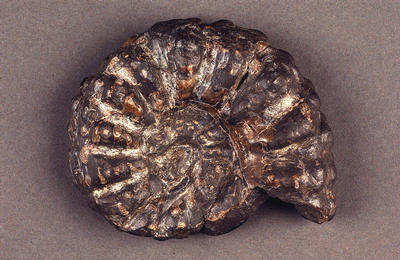
A fossil Tylonautilus found at Darnley.
Nautiloids are marine animals that first appeared around 505 million years ago during the upper Cambrian Period. They had tentacles and protective shells that were coiled like those of snails but were divided into chambers. New chambers were added to the shell as the nautiloid grew larger. The only living Nautiloid is Nautilus which lives in the Pacific Ocean. Active at night it swims through the water and preys on fish and crustaceans. Nautiloids are representatives of a group called cephalopods. As such it is related to the extinct ammonites and also the living squids and octopuses.
This Tylonautilus was found in the Arden Limestone. It lived during the Carboniferous Period (360-290 million years ago), when Scotland was on the edge of of a vast tropical landmass which lay near the equator. The land was very low-lying. Frequent changes in sea level during the Carboniferous resulted in the land being covered by warm shallow seas. Evidence of these floodings survives in the forms of fossilised shells, fish, corals and other marine creatures.
Reference: DB.2735
Reproduced with the permission of Glasgow City Council, Glasgow Museums
Keywords:
Carboniferous Period, cephalopods, flooding, fossils, geology, limestone, nautiloids, Tylonautilus
You have 0 images in your photo album.